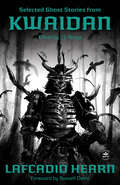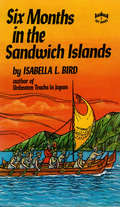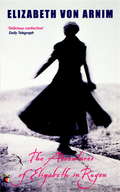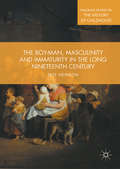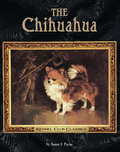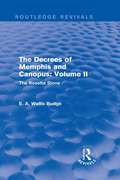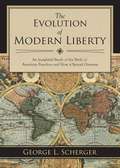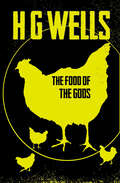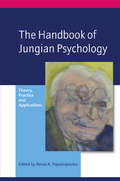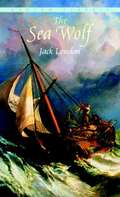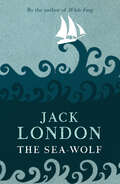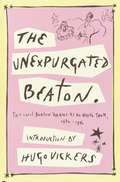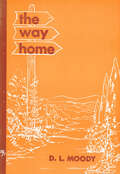- Table View
- List View
Selected Ghost Stories from Kwaidan
by Lafcadio HearnIn 1924, Lafcadio Hearn took his love of culture and myth and introduced us to the world of Japanese folklore with Kwaidan, his own collection of ghost stories. In this classic volume, you&’ll find tales that are hauntingly lyrical and complex. Japanese demons that eat flesh.Ghostly brides returning for their lovers. Lafcadio Hearn&’s ghost stories have become a fixture in the world of Japanese lore and superstition, offering us an eerie taste of what goes bump in the night. A blind performer plays for an audience of ghosts. A maiden reincarnates to search for her beloved. A nurse offers the ultimate sacrifice for her young charge. And a group of rokurokubi plot to end the life of a noble samurai. These classic tales celebrating Japanese culture are far different from our modern-day horror stories. Whether you&’re in the mood for phantoms, demons, ghouls, or ghosts, these otherworldly tales will haunt you long after you&’ve finished reading.
Sir John Beverley Robinson: Bone and Sinew of the Compact
by Patrick BrodeJohn Beverley Robinson (1791-1863) was one of Upper Canada's foremost jurists, a dominating influence on the ruling élite, and a leading citizen of nineteenth-century Toronto who owned a vast tract of land on which Osgoode Hall now stands. The loyalists had founded a colony firm in its devotion to the Crown, with little room for dissent. As a true loyalist son, educated by John Strachan, Robinson attempted to steer Upper Canada toward emulation of what he perceived to be Britain's ideal aristocratic society. As a young ensign in the York militia, he defended his sovereign at Queenston Heights, and as acting attorney-general he prosecuted traitors who threatened to undermine the colony. Later, as attorney-general and de facto leader of the assembly during the 1820s, he tried to mould the government to the British form. But factors he never understood--the influence of American democracy and liberalism in the Colonial Office--ensured that Upper Canada would never be a 'new Albion. ' Robinson was appointed chief justice in 1829, and his judicial career spanned thirty-three years, during which he insisted the courts were subservient to the legislature and established precedents declaring their role should be limited to the enforcement of existing laws, with no independent creative function. His long service on the bench represented both a preservation and a strengthening of the British tradition in Canadian law. In this biography, early Toronto comes alive through the eyes of a powerful man--firm in his beliefs, attractive to women, respected by his fellows--who sought to mould society to his own ideals. For historians, lawyers, and students of jurisprudence who seek an understanding of the roots of legal practice in nineteenth-century Ontario, it is essential reading.
Six Months in the Sandwich Islands
by Isabella L. BirdThis classic of Hawaiian literature offers a charming glimpse at the splendid and fascinating world of pre-American Hawaii.Isabella Lucy Bird won fame in her own time as the most remarkable woman traveler of the nineteenth century, and Six Months in the Sandwich Isles, in which she describes her sojourn in Hawaii in 1873, is one of the gems of Pacific literature. It is safe to say that no other book about Hawaii surpasses it in fascination. Much of the charm of Isabella's writing is due to her use of personal letters for conveying her her experiences and her impressions. The thirty-one letters that compose the book were written to her beloved sister Henrietta, who dutifully stayed at home in Edinburgh to take care of the household while Isabella was away on her travels.The book is an authentic record of daily life in Hawaii in the late nineteenth century. It describes a life style during the brief reign of King Lunalilo, not too may years before the sad reign of Queen Liliuokalani ended her dethronement by revolution. Isabella Bird met royalty, missionaries, cowboys, and ordinary, everyday Hawaiians. It is fortunate that she left such a vivid narrative of her Hawaiian Interlude.
Six Months in the Sandwich Islands
by Isabella L. BirdThis classic of Hawaiian literature offers a charming glimpse at the splendid and fascinating world of pre-American Hawaii.Isabella Lucy Bird won fame in her own time as the most remarkable woman traveler of the nineteenth century, and Six Months in the Sandwich Isles, in which she describes her sojourn in Hawaii in 1873, is one of the gems of Pacific literature. It is safe to say that no other book about Hawaii surpasses it in fascination. Much of the charm of Isabella's writing is due to her use of personal letters for conveying her her experiences and her impressions. The thirty-one letters that compose the book were written to her beloved sister Henrietta, who dutifully stayed at home in Edinburgh to take care of the household while Isabella was away on her travels.The book is an authentic record of daily life in Hawaii in the late nineteenth century. It describes a life style during the brief reign of King Lunalilo, not too may years before the sad reign of Queen Liliuokalani ended her dethronement by revolution. Isabella Bird met royalty, missionaries, cowboys, and ordinary, everyday Hawaiians. It is fortunate that she left such a vivid narrative of her Hawaiian Interlude.
The Adventures Of Elizabeth In Rugen: A Virago Modern Classic
by Elizabeth Von ArnimIn 1901 the 'real' Elizabeth holidayed on the Baltic island of Rügen with just her maid, a coachman, a carriage piled with luggage, and a woman friend. From such unpromising beginnings Elizabeth weaves a captivating farrago around her encounters. There's the snobbish bishop's wife and her personable, handsome son, a dressmaker and, astonishingly, a long-lost cousin -- Charlotte -- who is trying to evade the pursuit of her husband, the maddeningly genial old professor. Here, with delightfully astringent humour, Elizabeth recounts the misadventures that befall her. And, as she immortalised her Pomeranian wilderness in the famous ELIZABETH AND HER GERMAN GARDEN, she now writes enticingly of this remote and attractive island.
The Adventures Of Elizabeth In Rugen: A Virago Modern Classic (Virago Modern Classics #397)
by Elizabeth von ArnimIn 1901 the 'real' Elizabeth holidayed on the Baltic island of Rügen with just her maid, a coachman, a carriage piled with luggage, and a woman friend. From such unpromising beginnings Elizabeth weaves a captivating farrago around her encounters. There's the snobbish bishop's wife and her personable, handsome son, a dressmaker and, astonishingly, a long-lost cousin -- Charlotte -- who is trying to evade the pursuit of her husband, the maddeningly genial old professor. Here, with delightfully astringent humour, Elizabeth recounts the misadventures that befall her. And, as she immortalised her Pomeranian wilderness in the famous ELIZABETH AND HER GERMAN GARDEN, she now writes enticingly of this remote and attractive island.
The Boy-Man, Masculinity and Immaturity in the Long Nineteenth Century (Palgrave Studies in the History of Childhood)
by Pete NewbonThis book explores the evolution of male writers marked by peculiar traits of childlike immaturity. The ‘Boy-Man’ emerged from the nexus of Rousseau’s counter-Enlightenment cultural primitivism, Sensibility’s ‘Man of Feeling’, the Chattertonian poet maudit, and the Romantic idealisation of childhood. The Romantic era saw the proliferation of boy-men, who congregated around such metropolitan institutions as The London Magazine. These included John Keats, Leigh Hunt, Charles Lamb, Hartley Coleridge, Thomas De Quincey and Thomas Hood. In the period of the French Revolution, terms of childishness were used against such writers as Wordsworth, Keats, Hunt and Lamb as a tool of political satire. Yet boy-men writers conversely used their amphibian child-adult literary personae to critique the masculinist ideologies of their era. However, the growing cultural and political conservatism of the nineteenth century, and the emergence of a canon of serious literature, inculcated the relegation of the boy-men from the republic of letters.
The Business Side of Agriculture (Routledge Revivals)
by Arthur, G.L. RogersFirst Published in 1906, this book discusses farming in Britain, as well as exploring the business interests and concerns of the farmer whilst debating the future of traditional farming methods.
The Chihuahua
by Susan PayneThird in the Kennel Club Books' Classics series, The Chihuahua recognizes the ever-popular pequeño perrito in one spectacular volume. Written by author, breeder, and handler, Susan Payne, this book's engaging chapters on everything from the breed's accomplishments in performance events, to their participation as service dogs make it much more than just "another breed book." With more than 150 vintage and modern photographs of the breed, this book is a must-have for every Chihuahua owner.
The Decrees of Memphis and Canopus: The Decree of Canopus (Routledge Revivals)
by E. A. BudgeThis is the third of three volumes exploring some of the most remarkable insights into Ancient Egypt to have come to light in modern times. The first two volumes deal with the Rosetta Stone, an outstanding archaeological discovery which has supplied the basis for Egyptian decipherment; the final volume explores the "Stele of Canopus", discovered in 1866. The Decree inscribed on the Stele of Canopus was passed at a general Council of Egyptian priests, setting forth the good deeds of Ptolemy III, and enumerating the benefits that he and his wife Berenice had conferred upon Egypt. Yet, the real significance of the Stele is that, like the Rosetta Stone, the text is inscribed in Hieroglyphic, Greek and Demotic Egyptian. First published in 1904, this reissue provides an accessible general introduction to this fascinating subject, particularly useful for the amateur enthusiast as well as undergraduate students.
The Decrees of Memphis and Canopus: The Rosetta Stone (Routledge Revivals)
by E. A. BudgeThis is the first of three volumes exploring some of the most remarkable insights into Ancient Egypt to have come to light in modern times. The first two volumes deal with the Rosetta Stone, an outstanding archaeological discovery that has supplied the basis for Egyptian decipherment; the final volume explores the "Stele of Canopus", discovered in 1866. The significance of the Rosetta Stone lies in the three different languages that are inscribed onto it: Koine Greek, Demotic Egyptian, and, crucially, Hieroglyphic. This has facilitated a vast increase in our understanding of the sacred language of Ancient Egypt, as well as enhancing our understanding of the nature of kingship at a time of immense cultural transformation. First published in 1904, this reissue provides an accessible general introduction to this fascinating subject, useful for the amateur enthusiast as well as undergraduate students.
The Decrees of Memphis and Canopus: The Rosetta Stone (Routledge Revivals)
by E. A. BudgeThis is the second of three volumes exploring some of the most remarkable insights into Ancient Egypt to have come to light in modern times. The first two volumes deal with the Rosetta Stone, an outstanding archaeological discovery which has supplied the basis for Egyptian decipherment; the final volume explores the "Stele of Canopus", discovered in 1866. The significance of the Rosetta Stone lies in the three different languages inscribed on it: Koine Greek, Demotic Egyptian, and, crucially, Hieroglyphic. This has facilitated a vast increase in our understanding of the sacred language of Ancient Egypt, as well as enhancing our understanding of the nature of kingship at a time of immense cultural transformation. First published in 1904, this title provides an accessible general introduction to this fascinating subject, useful for the amateur enthusiast as well as undergraduate students.
The Evolution of Modern Liberty: An Insightful Study of the Birth of American Freedom and How It Spread Overseas
by George L. SchergerPublished for the first time in 1904, The Evolution of Modern Liberty was originally intended to be a comparison study of the American and French bills of rights. However, Scherger expanded his volume into much more--a timeless look at the modern idea of liberty and the steps taken to get there.A fragment of history in and of itself, this classic of early twentieth-century historical study is a must-have for the collection of any history or political buff. Coming up on its 110th year of publication, this volume is a fascinating insight on the notion of liberty, published during a time when it was still unfolding.
The Food of the Gods (Hesperus Classics)
by H. G. WellsPublished in 1904, this forgotten classic is sci-fi and dystopia at its best, written by the creator and master of the genreFollowing extensive research in the field of "growth," Mr. Bensington and Professor Redwood light upon a new mysterious element, a food that causes greatly accelerated development. Initially christening their discovery "The Food of the Gods," the two scientists are overwhelmed by the possible ramifications of their creation. Needing room for experiments, Mr. Besington chooses a farm that offers him the chance to test on chickens, which duly grow monstrous, six or seven times their usual size. With the farmer, Mr. Skinner, failing to contain the spread of the Food, chaos soon reigns as reports come in of local encounters with monstrous wasps, earwigs, and rats. The chickens escape, leaving carnage in their wake. The Skinners and Redwoods have both been feeding their children the compound illicitly—their eventual offspring will constitute a new age of giants. Public opinion rapidly turns against the scientists and society rebels against the world's new flora and fauna. Daily life has changed shockingly and now politicians are involved, trying to stamp out the Food of the Gods and the giant race. Comic and at times surprisingly touching and tragic, Wells' story is a cautionary tale warning against the rampant advances of science but also of the dangers of greed, political infighting, and shameless vote-seeking.
The Handbook of Jungian Psychology: Theory, Practice and Applications
by Renos K. PapadopoulosThe field of Jungian psychology has been growing steadily over the last twenty years and awareness is increasing of its relevance to the predicaments of modern life. Jung appeals not only to professionals who are looking for a more humane and creative way of working with their clients, but also to academics in an increasingly wide range of disciplines. This Handbook is unique in presenting a clear, comprehensive and systematic exposition of the central tenets of Jung’s work which has something to offer to both specialists and those seeking an introduction to the subject. Internationally recognised experts in Jungian Psychology cover the central themes in three sections: Theory, Psychotherapy & Applications. Each chapter begins with an introduction locating the topic in the context of Jung’s work as a whole, before moving on to an investigation of contemporary developments and concluding by demonstrating how Jung’s theories continue to evolve and develop through their practical therapeutic applications. The Handbook of Jungian Psychology is the definitive source of authoritative information on Jungian psychology for Jungian analysts, psychotherapists, counsellors and related professionals. It will be an invaluable aid to those involved in Jungian academic studies and related disciplines.
The Heart of Japan: Glimpses of Life and Nature Far From the Travellers' Track in the Land of the Rising Sun (Routledge Revivals)
by Brownell Clarence LudlowThis collection of commentaries and reflections on Japanese culture, first published in 1904, was written shortly after the return of two English aristocrats from five years spent immersed in the ‘Land of the Rising Sun’. Their intention through these anecdotes – some humorous and charming, others tragic and thought-provoking – was to offer glimpses into the "real inner spirit of the native life," and to provide insights into the remarkable idiosyncrasies of Japanese society during a period of unprecedented change. Touching on such diverse topics as sport, religion, music, censorship, drama and bathing, The Heart of Japan will be of particular interest to students of Japanese, as well as to those intrigued by cultural difference and exchange.
The History Of Mr Polly: With an introduction by Giles Foden
by H.G. WellsMr Polly is an ordinary middle-aged man who is tired of his wife's nagging and his dreary job as the owner of a regional gentleman's outfitters. Faced with the threat of bankruptcy, he concludes that the only way to escape his frustrating existence is by burning his shop to the ground and killing himself. Unexpected events, however, conspire to lead the bewildered Mr Polly to a bright new future - after he saves a life, fakes his death, and escapes to a world of heroism and hope.
The Korea & Her Neighbours
by Isabella BirdIn Korea and Her Neighbours, written in two volumes between 1894 and 1897, Isabella Bird documents one of the most critical and interesting periods of Korean history. Violently torn from centuries of seclusion, this fragile nation awoke to find itself confronted on all sides by an array of powerful, ambitious, and aggressive countries clamoring for commercial and political concessions - a rivalry which, at this time, made Korea the battlefield of the first Sino-Japanese war. In the midst of political turmoil and international intrigue, the author offers an extraordinarily accurate description of almost every facet of the country covering such topics as the climate, geography, the living conditions of the people, the structure of government, indigenous religions, customs, and foreign trade treaties. Included is a chilling description of the assassination of Korea's queen, and an account of Isabella Bird's undaunted travels in Manchuria, China, and Russia, where she reported on the military tension at the Korean borders.
The Money Market (Routledge Library Editions: History of Money, Banking and Finance #10)
by F. StrakerThis book, first published in 1904, is an early examination of England’s monetary system: what it is, how it was founded, grew and developed. It analyses the role of trade in this development, and works from the assumption that the material well-being of the country and all its inhabitants is largely dependent upon the money market.
The Sea Wolf
by Jack LondonThe Sea Wolf is Jack London’s powerful and gripping saga of Humphrey Van Weyden, captured by a seal-hunting ship and now an unwilling sailor under its dreaded captain, Wolf Larsen. The men who sailed with Larsen were treacherous outcasts, but the captain himself was the legendary Sea Wolf–a violent brute of a man.Jack London was a worshipper of the strong and virtuous hero, and a firm believer in the inevitable triumph of good. The master storyteller nowhere demonstrates this theme more vividly than in this classic American tale of peril and adventure, good and evil.
The Sea-Wolf (Hesperus Classics)
by Jack LondonJack London's thrilling narrative of the seven seas remains just as gripping today as it was 100 years agoA classic tale of adventure at sea, this is the story of the naïve young Humphrey van Weyden, whose ship is wrecked in a terrible storm. He is rescued by the mysterious Captain Wolf Larsen of the ship Ghost. Humphrey's new life aboard Ghost will test him to the limits of his endurance but also bring him the greatest happiness he has ever known. Captain Wolf Larsen is a powerful, brutal man with a razor sharp intelligence. When there is an attempted mutiny on board he shows no mercy to the would-be mutineers, and when his brother Death Larsen attempts to take over the Ghost by force, there is no love lost between them in their vicious battle. Wolf's cruel manner is thrown into sharp relief by the gentle spirit of the beautiful poetess also rescued, Maud Brewster, who charms both Wolf and Humphrey. As Humphrey falls in love with Maud, he must contend not only with the dangers of being at sea but with competition from his cruel and scheming captain. This dramatic tale of mutiny and shipwreck is at its heart the story of a love that flourishes in the unlikeliest of places.
The Unexpurgated Beaton
by Cecil Beaton Hugo VickersCecil Beaton was one of the great twentieth-century tastemakers. A photographer, artist, writer and designer for more than fifty years, he was at the center of the worlds of fashion, society, theater and film. The Unexpurgated Beaton brings together for the first time the never-before-published diaries from 1970 to 1980 and, unlike the six slim volumes of diaries published during his lifetime, these have been left uniquely unedited. Hugo Vickers, the executor of Beaton's estate and the author of his acclaimed biography, has added extensive and fascinating notes that are as lively as the diary entries themselves. As one London reviewer wrote, "Vickers' waspish footnotes are the salt on the side of the dish." Beaton treated his other published diaries like his photographs, endlessly retouching them, but, for this volume, Vickers went back to the original manuscripts to find the unedited diaries. Here is the photographer for British and American Vogue, designer of the sets and costumes for the play and film My Fair Lady and the film Gigi, with a cast of characters from many worlds: Bianca Jagger, Greta Garbo, David Hockney, Truman Capote, the Queen Mother and Princess Margaret, Mae West, Elizabeth Taylor, Marlene Dietrich, Rose Kennedy and assorted Rothschilds, Phippses and Wrightsmans; in New York, San Francisco, Palm Beach, Rio and Greece, on the Amalfi coast; at shooting parties in the English countryside, on yachts, at garden parties at Buckingham Palace, at costume balls in Venice, Paris or London. Beaton had started as an outsider and "developed the power to observe, first with his nose pressed up against the glass," and then later from within inner circles. Vickers has said, "his eagle eye missed nothing," and his diaries are intuitive, malicious (he took a "relish in hating certain figures"), praising and awestruck. Truman Capote once said "the camera will never be invented that could capture or encompass all that he actually sees." The Unexpurgated Beaton is a book that is not only a great read and wicked fun but a timeless chronicle of our age.From the Hardcover edition.
The Voyageur Classic Canadian Fiction 7-Book Bundle: All Else Is Folly / Pauline Johnson / The Town Below / Self Condemned / Storm Below / The Yellow Briar / Maria Chapdelaine
by Ford Madox Ford W. H. Blake Louis Hemon Brian Busby Hugh Garner Pauline Johnson Michael Gnarowski Roger Lemelin Peregrine Acland Paul Stuewe Patrick Slater Wyndham Lewis Allan PeroVoyageur Classics is a series of special new versions of Canadian classics, with added material and special introductions by noted experts. This bundle contains some of the greatest Canadian fiction, including influential literature from Quebec (Maria Chapdelaine, The Town Below), a collection of the best of the legendary Pauline Johnson, Peregrine Acland’s gripping Great War novel All Else is Folly, a classic tale of Irish immigration (The Yellow Briar), and great novels from the renowned Hugh Garner (The Storm Below) and Wyndham Lewis (Self Condemned). Any reader with an interest not only in Canadian literature, but in great fiction in general, will find this collection of great works an essential addition to their collection. Includes All Else Is Folly Pauline Johnson The Town Below Self Condemned Storm Below The Yellow Briar Maria Chapdelaine
The Way Home (Colportage Library #105)
by Dwight L. MoodyWhat does it mean to have faith? In a simple and honest way, D.L. Moody uses real life examples to answer your questions regarding Jesus, sin, salvation, forgiveness, death, and the afterlife.First published in 1904, The Way Home describes the timeless message of salvation for those who will receive it. Deepen your understanding of faith, and find peace with the Savior.
The Way Home (Colportage Library #105)
by Dwight L. MoodyWhat does it mean to have faith? In a simple and honest way, D.L. Moody uses real life examples to answer your questions regarding Jesus, sin, salvation, forgiveness, death, and the afterlife.First published in 1904, The Way Home describes the timeless message of salvation for those who will receive it. Deepen your understanding of faith, and find peace with the Savior.
